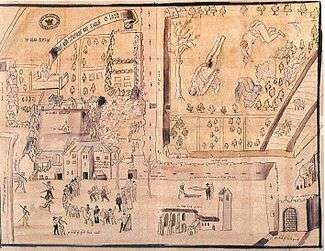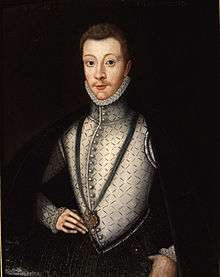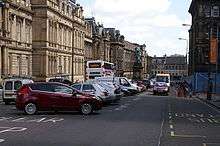Kirk o' Field

Kirk o' Field in Edinburgh, Scotland, is best known as the site of the murder on 10 February 1567 of Lord Darnley, second husband of Mary, Queen of Scots. The site was occupied by the collegiate church of St Mary in the Fields, or the Kirk o' Field. It was approximately ten minutes' walk from Holyrood Palace, adjacent to the city wall, near to the Cowgate. The site is close to the location of the National Museum of Scotland.
Darnley's murder
On his return to Edinburgh with Queen Mary early in 1567, Darnley took residence in the Old Provost's lodging, a two-storey house within the church quadrangle. The house was owned by Robert Balfour, whose brother Sir James Balfour was a prominent councillor of Queen Mary. Adjacent was the lodging of James Hamilton, Duke of Châtellerault. At first Darnley's household thought he would be accommodated in the Hamilton Lodging.

Early in the morning of 10 February, the house was destroyed by a gunpowder explosion while Queen Mary was at Holyrood attending the wedding celebration of Bastian Pagez. The partially clothed bodies of Darnley and his servant were found in a nearby orchard, apparently either smothered or strangled but unharmed by the explosion. Another servant was killed in the house by the explosion, which it was said had such, "a force and vehemency, that of the haill ludgeing, walles and uthir, their is na thing left unruinated and doung in drosse to the verie ground stane."[1]
Three witnesses made sworn statements on the following day. Barbara Mertine said she was looking out of the window of her house in Friar's Wynd, and heard 13 men go through the Friar Gate into Cowgate and up Friar's Wynd. Then she heard the explosion, the "craik rais," and 11 more men went by. She shouted after them that they were traitors after an "evill turn." May Crokat lived opposite Barbara, under the Master of Maxwell's lodging. May was in bed with her twins and heard the explosion. She ran to the door in her shirt (sark) and saw the 11 men. May grabbed at one man and asked about the explosion, receiving no answer. John Petcarne, a surgeon who lived in the same street heard nothing, but was summoned to attend Francis Busso, a servant of Queen Mary.[2]
Later, James Melville of Halhill wrote in his Memoirs that a page said Darnley was taken out of the house before the explosion and was choked to death in a stable with a serviette in his mouth, then left under a tree. Melville went to Holyroodhouse the next day and spoke to the Earl of Bothwell, who told him that thunder or a flash had come out of the sky, "souder came out of the luft," and burnt the house and there was "not a hurt nor a mark" on the body.[3] Melville said that the royal servant Alexander Durham (of Duntarvie) kept the body and stopped him seeing it.[4]
On 12 February the Privy Council issued a proclamation that the first to reveal the names of the conspirators and participants in the murder would be pardoned, if they were involved, and have a reward of £2,000.[5]
Aftermath
Suspicion was placed upon Queen Mary and James Hepburn, 4th Earl of Bothwell, one of her most trusted noblemen. Although Bothwell was accused of being the lead conspirator in Lord Darnley's murder by Lord Lennox, Bothwell was subsequently found not guilty at trial by the Privy council of Scotland in April 1567. After his acquittal, Bothwell made his supporters sign a pledge called the Ainslie Tavern Bond. Queen Mary married Bothwell the following month, three months after Darnley's murder. In her letters, Queen Mary defended her choice of husband, stating that she felt that she and the country were in danger and that Lord Bothwell was proven both in battle and as a defender of Scotland: "...the true occasions which has moved us to take the Duke of Orkney [Bothwell] to husband..."[6][7]
Bothwell's enemies, called the Confederate Lords, gained control of Edinburgh and captured the Queen at the battle of Carberry Hill. The Confederate Lords claimed that their disapproval of the marriage to Bothwell was the cause of their rebellion. Bothwell escaped, but four of his men who were already in prison were put to torture on 26 June 1567, being "put in the irnis (irons) and turmentis, for furthering the tryall of the veritie." The Privy Council, led by the Earl of Morton, noted this application of torture was a special case, and the method was not to be used in other cases.[8] Mary, in prison at Lochleven Castle, abdicated.
Darnley's death remains one of the great unsolved historical mysteries, compounded by the rumoured discovery of and controversy about the authenticity of the Casket letters which were alleged to incriminate Queen Mary in the murder plot. Mary's half-brother, James Stewart, Earl of Moray, who became Regent of Scotland after Mary's execution, is reputed to have signed the Craigmillar Bond with other Lords in December 1566 pledging to dispose of Lord Darnley.
Trials and convictions

Records of the subsequent trials with statements from the accused and witnesses are an important source of information on the events of February 1567. Most were published in Pitcairn's Ancient Criminal Trials in Scotland and Malcolm Laing's History of Scotland.[9] The accused were interrogated after Mary's abdication. Alternative theories of the murder have to disregard their evidence. Captain William Blackadder, an associate of Bothwell, was one of the first to be executed on 14 June 1567, although it was said he was only a bystander. Lord Herries wrote in 1656 that Blackadder rushed out of a tavern at the Tron on the Royal Mile at the sound of the explosion and was arrested.[10] He swore he was innocent before an assize made of Lennox men, tenants of Darnley's father, and was hanged drawn and quartered.[11] In December 1567, John Hepburn of Boltoun (John of Bowtoun), John Hay heir apparent of Tallo, William Powrie and George Dalgleish, all servants of Bothwell, were put on trial. They were condemned to be hanged and quartered. The head of Dalgleish, who had delivered the casket letters to the Earl of Morton, was set on the Netherbow gate of Edinburgh.[12]
William Powrie had made a statement in June, which describes how he and his companions carried the powder to the King's Lodging. He included the detail that as they were carrying the empty chests back up Blackfriar's Wynd, they saw the Queen and her party, "gangand before thame with licht torches."[13] Thomas Nelson, a servant in Darnley's bedchamber noted that it was first thought they would go to stay at Craigmillar Castle, then the Duke's Lodging at Kirk o'Field. When they arrived at the Provost's Lodging, Mary had organised hangings for the chamber and a new black velvet bed. Robert Balfour, the owner gave Nelson the keys, except those of the door in the cellar which exited south through the town wall. After a couple of nights the Queen had the black bed replaced with an old purple one, because bath water might spoil the new bed, and she put a green bed for herself in a lower (laich) chamber.[14] George Buchanan argued in his History of Scotland published in 1582, that this substitution for the new bed proved Mary's involvement in the murder.[15]
The French valet, Nicolas Haubert called Paris, said that Bothwell came to the lodging with Mary, and making the excuse that he needed the toilet, took Paris aside and asked him for the keys. Paris explained that it was not his role to hold the keys. Bothwell told him of his plans. Paris was troubled by the conversation, and went to pace up and down in St Giles Kirk. Fearful of the conspiracy he considered taking ship at Leith. In his second interrogation Paris named Captain Blackadder, who had already been executed. Paris was executed on 16 August 1567.[16]
Some conspiracy theories
One longstanding theory is the suggestion that the Earls of Morton and Moray were behind the murder, directing Bothwell's actions, to forward Moray's ambitions. These Earls made a denial of their involvement in their lifetime. The later and partisan Memoirs written by John Maxwell, Lord Herries in 1656, follow and develop this line of reasoning. Herries, after considering the arguments of previous writers, believed that Mary herself was innocent of involvement, and the two Earls arranged her marriage to Bothwell.[17]
After the explosion, Sir William Drury reported to the English Secretary of State William Cecil, 1st Baron Burghley, that James Balfour had purchased gunpowder worth 60 pounds Scots shortly beforehand.[6] Balfour could have stored the powder at the property next-door, also owned by the Balfours, and then mined the prince's lodgings by moving the powder from one cellar to the next.[6][18] However, this James Balfour was the captain of Edinburgh Castle and was likely to buy powder for use at the Castle.
The home of James Hamilton, Duke of Châtellerault, lay in the same quadrangle, and Hamilton was an old enemy of Darnley's family, as they had competing claims in the line of succession to the Scottish throne. Hamilton was also related to the Douglas family, who were no friends of Darnley either. There is no shortage of suspects, and the full facts of the murder have never been deduced.
Sketches sent to England
A contemporary drawing of the murder scene at Kirk o' Field includes at the top left the infant James VI sitting up in his cot praying: "Judge and avenge my cause, O Lord;" in the centre lie the rubble remains of the house; to the right Darnley and his servant lie dead in the orchard; below, the townspeople of Edinburgh gather round and four soldiers remove a body for burial. The artist was employed by Sir William Drury, Marshall of Berwick, who sent the sketch to England.
The murder scene sketch has been dated 9 February 1567, (in error.)[19] The sketch includes several cryptic elements. At first it appears to be an eye-witness account of the murder scene. However the infant James was not present, nor could he speak the words attributed to him at the time. Thus the image changes by its inclusion from an eye-witness account, to a propaganda poster, as an allegory. This same motto and a similar image of father and son was used on the banner of the rebel Confederate Lords, first displayed at Edinburgh castle,[20] then at the battle of Carberry Hill. This banner was described by the French ambassador, and a sketch of the banner was also sent to England. It shows the town wall and the open door to the lodging (mentioned in Thomas Nelson's statement) in the background.[21] A mystery in the Kirk o'Field plan may be the image of the mounted riders in the far right picture. Some riders at night were mentioned a week later as being a band of men led by Andrew Kerr who were present the night of the murder. It is unclear how the artist drawing the scene the following day knew to include the image of these night riders, if such they are, not known to be present until a week later.[6][22]
A placard was created and distributed throughout Edinburgh which portrayed Mary as a seductive mermaid. The author of the mermaid placard was never identified, and again a copy was sent to England.[23]
The Kirk o'Field site
The lands at Kirk o' Field went on to be granted to the city specifically for the foundation of a new university, including the Hamilton lodging. The University of Edinburgh was founded by King James VI in 1582, and the Kirk o' Field site has long been considered to be at the current location of the Old College. Recent archaeological investigations following the Cowgate fire of 2002 have raised some questions about the exact location of the house.[24]
References
- ↑ Register of the Privy Council of Scotland, vol.1 (1877), p.498, Proclamation 12 February 1567
- ↑ Bain, Joseph, ed., Calendar of State Papers Scotland, vol.2 (1900), pp.312–3
- ↑ Scott, George, ed., The Memoires of Sir James Melvil of Hal-Hill, Robert Boulter, London (1683), 78, Anglicised edition.
- ↑ Thomson, Thomas, ed., Melville's Memoirs of his own life, (1827), pp.174–175 Scots language
- ↑ Register of the Privy Council of Scotland, vol.1 (1877), p.498
- 1 2 3 4 Fraser, Antonia (1994) [1969]. Mary Queen of Scots. London: Weidenfeld and Nicolson. p. 299. ISBN 0-297-17773-7.
- ↑ Guy, John (2004). "My Heart is my Own": The Life of Mary Queen of Scots. London: Fourth Estate. p. 342. ISBN 1-84115-753-8.
- ↑ Register of the Privy Council of Scotland, vol.1 (1877), p.525
- ↑ See external links
- ↑ Lord Herries, Historical memoirs of the reign of Mary queen of scots and a portion of the reign of king James the Sixth, (1837), pp.84
- ↑ Diurnal of Occurents, (1833), pp.114–5
- ↑ Pitcairn, vol.1 part 2 (1833), 488–492
- ↑ Pitcairn, vol.1 part2 (1833), 493
- ↑ Pitcairn, vol.1 part 2 (1833), 501–2
- ↑ Aikman, James, trans., Buchanan's History of Scotland, vol.2 (1827), p.493
- ↑ Pitcairn, vol.1 part 2 (1833), 503–511 (French)
- ↑ Lord Herries, Historical memoirs of the reign of Mary queen of scots and a portion of the reign of king James the Sixth, (1837), pp.82–95
- ↑ Guy, John (2004). "My Heart is my Own": The Life of Mary Queen of Scots. London: Fourth Estate. p. 295. ISBN 1-84115-753-8.
- ↑ Calendar of State Papers Foreign, Elizabeth, vol. 8: 1566–1568 (1871), pp. 170–183, no.941
- ↑ Calendar State Papers Spain (Simancas), vol.1 (1871), no.427
- ↑ Labanoff, A., ed, Lettres de Marie Stuart, vol. 7, London, Dolman, (1852), 121, M. Du Croc to Charles IX, 17 June 1567: Calendar of State Papers Foreign, Elizabeth, vol. 8: 1566–1568 (1871), pp. 241–252, no.1300: picture in Loades, David, Elizabeth I, National Archives, (2003), 69
- ↑ Guy, John (2004). "My Heart is my Own": The Life of Mary Queen of Scots. London: Fourth Estate. p. 293. ISBN 1-84115-753-8.
- ↑ Calendar of State Papers Foreign, Elizabeth, vol. 8: 1566–1568 (1871), pp. 241–252: picture in Loades, David, Elizabeth I, National Archives, (2003), 73
- ↑ http://thescotsman.scotsman.com/index.cfm?id=592222003 thescotsman.scotsman.com
Further reading
- George Buchanan, Ane Detectioun of the Duings of Marie Quene of Scottes, touchand the murder of hir husband, (1571), from University of Birmingham, Philological Museum
- Pitcairn, Robert, ed., Criminal Trials in Scotland, vol.1 part 2, (1833), pp. 488–513, original confessions of accessories
- Laing, Malcolm, History of Scotland with a Preliminary Dissertation on the Participation of Mary, Queen of Scots, in the Murder of Darnley, vol. 2 (1819) includes the confessions, the casket letters, and other relevant documents.
- "Kirk O' Field, the University and the Hospitals". Retrieved 20 May 2007.
- "Kirk o 'Field – Moray's Propaganda Victory". Retrieved 31 May 2007.
- "The Murder of Lord Darnley". Retrieved 20 May 2007.
- Weir, Alison (2004). Mary, Queen of Scots and the Murder of Lord Darnley. London: Pimlico. ISBN 0-7126-6456-4.
- Armstrong Davidson, Meredith H. (1965). The Casket Letters: A Solution to the Mystery of Mary Queen of Scots and the Murder of Lord Darnley. Washington DC: University Press. ASIN B0000CMRLB.
- Mahon, Reginald H. (1930). The Tragedy of Kirk O' Field. Cambridge University Press. ASIN B000KT17WQ.
Coordinates: 55°56′44″N 3°10′52″W / 55.9456°N 3.1811°W
